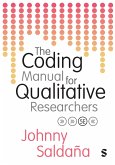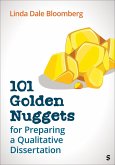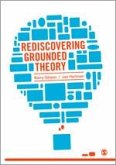Juliet Corbin, Anselm Strauss
Basics of Qualitative Research
Techniques and Procedures for Developing Grounded Theory
Juliet Corbin, Anselm Strauss
Basics of Qualitative Research
Techniques and Procedures for Developing Grounded Theory
- Broschiertes Buch
- Merkliste
- Auf die Merkliste
- Bewerten Bewerten
- Teilen
- Produkt teilen
- Produkterinnerung
- Produkterinnerung
The bestseller continues to offer immensely practical advice and technical expertise to aid researchers in making sense of their collected data.
Andere Kunden interessierten sich auch für
![The Coding Manual for Qualitative Researchers The Coding Manual for Qualitative Researchers]() Johnny SaldanaThe Coding Manual for Qualitative Researchers38,99 €
Johnny SaldanaThe Coding Manual for Qualitative Researchers38,99 €![101 Golden Nuggets for Preparing a Qualitative Dissertation 101 Golden Nuggets for Preparing a Qualitative Dissertation]() Linda Dale Bloomberg101 Golden Nuggets for Preparing a Qualitative Dissertation39,99 €
Linda Dale Bloomberg101 Golden Nuggets for Preparing a Qualitative Dissertation39,99 €![Discovering Statistics Using JASP Discovering Statistics Using JASP]() Andy FieldDiscovering Statistics Using JASP46,99 €
Andy FieldDiscovering Statistics Using JASP46,99 €![The Meaning of Contemplation for Social Qualitative Research The Meaning of Contemplation for Social Qualitative Research]() Krzysztof T. KoneckiThe Meaning of Contemplation for Social Qualitative Research154,99 €
Krzysztof T. KoneckiThe Meaning of Contemplation for Social Qualitative Research154,99 €![Data Analysis in Qualitative Research Data Analysis in Qualitative Research]() Stefan TimmermansData Analysis in Qualitative Research14,99 €
Stefan TimmermansData Analysis in Qualitative Research14,99 €![Rediscovering Grounded Theory Rediscovering Grounded Theory]() Barry GibsonRediscovering Grounded Theory53,99 €
Barry GibsonRediscovering Grounded Theory53,99 €![Data Visualisation Data Visualisation]() Andy KirkData Visualisation99,99 €
Andy KirkData Visualisation99,99 €-
-
-
The bestseller continues to offer immensely practical advice and technical expertise to aid researchers in making sense of their collected data.
Produktdetails
- Produktdetails
- Verlag: Sage Publications
- Artikelnr. des Verlages: B97461P
- 4th ed.
- Seitenzahl: 456
- Erscheinungstermin: März 2015
- Englisch
- Abmessung: 232mm x 187mm x 28mm
- Gewicht: 1166g
- ISBN-13: 9781412997461
- ISBN-10: 1412997461
- Artikelnr.: 39254394
- Herstellerkennzeichnung
- Libri GmbH
- Europaallee 1
- 36244 Bad Hersfeld
- gpsr@libri.de
- Verlag: Sage Publications
- Artikelnr. des Verlages: B97461P
- 4th ed.
- Seitenzahl: 456
- Erscheinungstermin: März 2015
- Englisch
- Abmessung: 232mm x 187mm x 28mm
- Gewicht: 1166g
- ISBN-13: 9781412997461
- ISBN-10: 1412997461
- Artikelnr.: 39254394
- Herstellerkennzeichnung
- Libri GmbH
- Europaallee 1
- 36244 Bad Hersfeld
- gpsr@libri.de
Juliet Corbin (MS, nursing, DNSc, nursing) is retired from her position as an instructor in the School of Nursing at San Jose State University and an adjunct professor at the International Institute for Qualitative Methodology, University of Alberta. She continues to conduct workshops in grounded theory throughout the world and consults with those who conduct grounded theory studies. Professor Corbin was a co-editor and co-author with Anselm Strauss on Unending Work and Care (1988) and Grounded Theory in Practice (1997). Her research interests are in qualitative methodology, chronic illness, and the sociology of work. Anselm Strauss, internationally renowned medical sociologist and co-creator of grounded theory, is late of the University of California, San Francisco, where he was professor emeritus in the Department of Social and Behavioral Sciences. He was a co-editor and co-author with Juliet Corbin on Unending Work and Care (1988) and Grounded Theory in Practice (1997).
Part I: Introduction to Grounded Theory of Anselm Strauss
Chapter 1: Inspiration and Background
Chapter 2: Theoretical Foundations
Chapter 3: Practical Considerations for Getting Started
Chapter 4: Prelude to Analysis
Chapter 5: Strategies for Qualitative Data Analysis
Chapter 6: Memos and Diagrams
Chapter 7: Theoretical Sampling
Chapter 8: Context
Chapter 9: Process
Chapter 10: Techniques for Achieving Theoretical Integration
Chapter 11: The Use of Computer Programs in Qualitative Data Analysis
Part II: Research Demonstration Project
Chapter 12 Open Coding: Identifying Concepts
Chapter 13: Developing Concepts in Terms of Their Properties and Dimensions
Chapter 14: Analyzing Data for Context
Chapter 15: Bringing Process Into the Analysis
Chapter 16: Integrating Categories
Part III: Finishing the Research Project
Chapter 17: Writing Theses, Monographs, and Dissertations, and Giving Talks About Your Research
Chapter 18: Criteria for Evaluation
Chapter 19: Student Questions and Answers
Chapter 1: Inspiration and Background
Chapter 2: Theoretical Foundations
Chapter 3: Practical Considerations for Getting Started
Chapter 4: Prelude to Analysis
Chapter 5: Strategies for Qualitative Data Analysis
Chapter 6: Memos and Diagrams
Chapter 7: Theoretical Sampling
Chapter 8: Context
Chapter 9: Process
Chapter 10: Techniques for Achieving Theoretical Integration
Chapter 11: The Use of Computer Programs in Qualitative Data Analysis
Part II: Research Demonstration Project
Chapter 12 Open Coding: Identifying Concepts
Chapter 13: Developing Concepts in Terms of Their Properties and Dimensions
Chapter 14: Analyzing Data for Context
Chapter 15: Bringing Process Into the Analysis
Chapter 16: Integrating Categories
Part III: Finishing the Research Project
Chapter 17: Writing Theses, Monographs, and Dissertations, and Giving Talks About Your Research
Chapter 18: Criteria for Evaluation
Chapter 19: Student Questions and Answers
Preface
Chapter 1: Introduction
Chapter 2: Practical Considerations
Chapter 3: Prelude to Analysis
Chapter 4: Strategies for Qualitative Data Analysis
Chapter 5: Introduction to Context, Process and Theoretical Integration
Chapter 6: Memos and Diagrams
Chapter 7: Theoretical Sampling
Chapter 8: Analyzing Data for Concepts
Chapter 9: Elaborating the Analysis
Chapter 10: Analyzing Data for Context
Chapter 11: Bringing Process into the Analysis
Chapter 12: Integrating Around a Concept
Chapter 13: Writing Theses, Monographs, and Giving Talks
Chapter 14: Criterion for Evaluation
Chapter 15: Student Questions and Answers
Index
Chapter 1: Introduction
Chapter 2: Practical Considerations
Chapter 3: Prelude to Analysis
Chapter 4: Strategies for Qualitative Data Analysis
Chapter 5: Introduction to Context, Process and Theoretical Integration
Chapter 6: Memos and Diagrams
Chapter 7: Theoretical Sampling
Chapter 8: Analyzing Data for Concepts
Chapter 9: Elaborating the Analysis
Chapter 10: Analyzing Data for Context
Chapter 11: Bringing Process into the Analysis
Chapter 12: Integrating Around a Concept
Chapter 13: Writing Theses, Monographs, and Giving Talks
Chapter 14: Criterion for Evaluation
Chapter 15: Student Questions and Answers
Index
Part I: Introduction to Grounded Theory of Anselm Strauss
Chapter 1: Inspiration and Background
Chapter 2: Theoretical Foundations
Chapter 3: Practical Considerations for Getting Started
Chapter 4: Prelude to Analysis
Chapter 5: Strategies for Qualitative Data Analysis
Chapter 6: Memos and Diagrams
Chapter 7: Theoretical Sampling
Chapter 8: Context
Chapter 9: Process
Chapter 10: Techniques for Achieving Theoretical Integration
Chapter 11: The Use of Computer Programs in Qualitative Data Analysis
Part II: Research Demonstration Project
Chapter 12 Open Coding: Identifying Concepts
Chapter 13: Developing Concepts in Terms of Their Properties and Dimensions
Chapter 14: Analyzing Data for Context
Chapter 15: Bringing Process Into the Analysis
Chapter 16: Integrating Categories
Part III: Finishing the Research Project
Chapter 17: Writing Theses, Monographs, and Dissertations, and Giving Talks About Your Research
Chapter 18: Criteria for Evaluation
Chapter 19: Student Questions and Answers
Chapter 1: Inspiration and Background
Chapter 2: Theoretical Foundations
Chapter 3: Practical Considerations for Getting Started
Chapter 4: Prelude to Analysis
Chapter 5: Strategies for Qualitative Data Analysis
Chapter 6: Memos and Diagrams
Chapter 7: Theoretical Sampling
Chapter 8: Context
Chapter 9: Process
Chapter 10: Techniques for Achieving Theoretical Integration
Chapter 11: The Use of Computer Programs in Qualitative Data Analysis
Part II: Research Demonstration Project
Chapter 12 Open Coding: Identifying Concepts
Chapter 13: Developing Concepts in Terms of Their Properties and Dimensions
Chapter 14: Analyzing Data for Context
Chapter 15: Bringing Process Into the Analysis
Chapter 16: Integrating Categories
Part III: Finishing the Research Project
Chapter 17: Writing Theses, Monographs, and Dissertations, and Giving Talks About Your Research
Chapter 18: Criteria for Evaluation
Chapter 19: Student Questions and Answers
Preface
Chapter 1: Introduction
Chapter 2: Practical Considerations
Chapter 3: Prelude to Analysis
Chapter 4: Strategies for Qualitative Data Analysis
Chapter 5: Introduction to Context, Process and Theoretical Integration
Chapter 6: Memos and Diagrams
Chapter 7: Theoretical Sampling
Chapter 8: Analyzing Data for Concepts
Chapter 9: Elaborating the Analysis
Chapter 10: Analyzing Data for Context
Chapter 11: Bringing Process into the Analysis
Chapter 12: Integrating Around a Concept
Chapter 13: Writing Theses, Monographs, and Giving Talks
Chapter 14: Criterion for Evaluation
Chapter 15: Student Questions and Answers
Index
Chapter 1: Introduction
Chapter 2: Practical Considerations
Chapter 3: Prelude to Analysis
Chapter 4: Strategies for Qualitative Data Analysis
Chapter 5: Introduction to Context, Process and Theoretical Integration
Chapter 6: Memos and Diagrams
Chapter 7: Theoretical Sampling
Chapter 8: Analyzing Data for Concepts
Chapter 9: Elaborating the Analysis
Chapter 10: Analyzing Data for Context
Chapter 11: Bringing Process into the Analysis
Chapter 12: Integrating Around a Concept
Chapter 13: Writing Theses, Monographs, and Giving Talks
Chapter 14: Criterion for Evaluation
Chapter 15: Student Questions and Answers
Index








